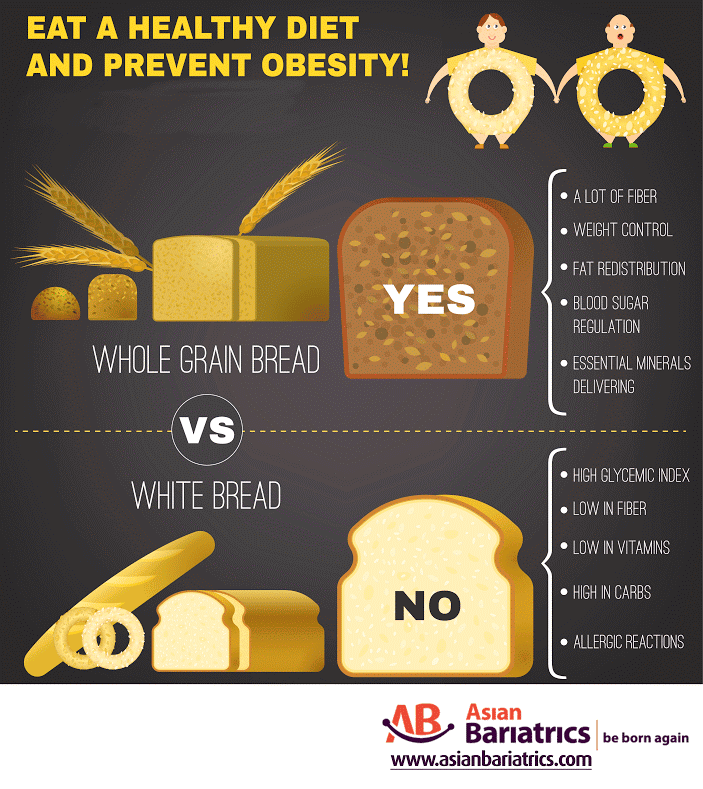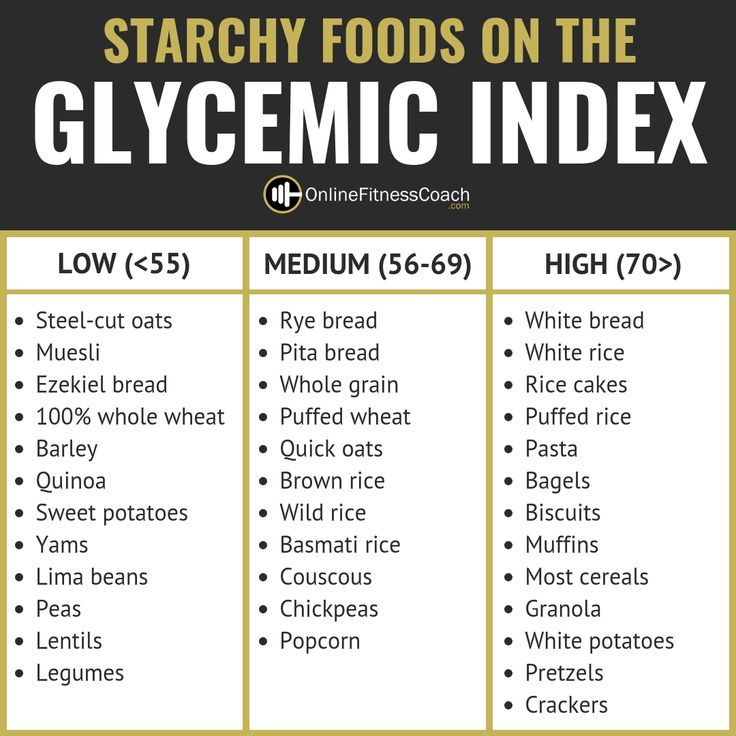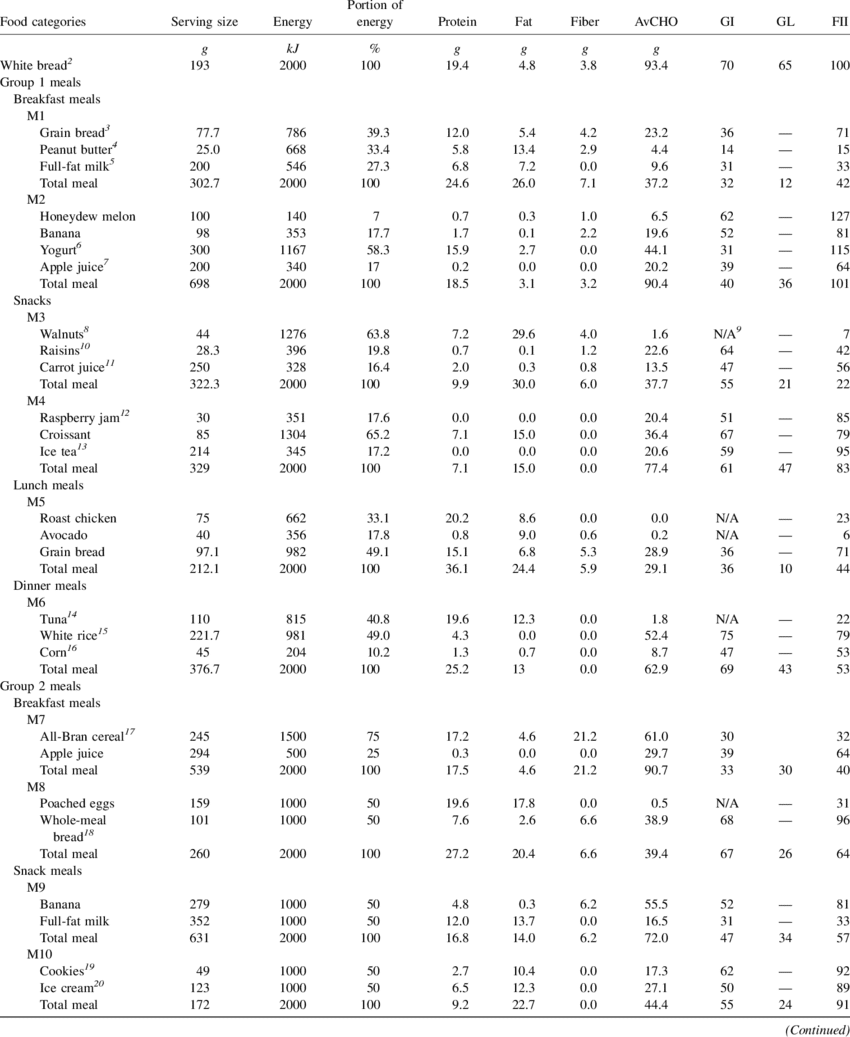Digesting And Absorbing Carbohydrates
The digestive system breaks down carbohydrates in foods and drinks into simple sugars, mainly glucose. For example, both rice and soft drink will be broken down to simple sugars in your digestive system. This simple sugar is then carried to your bodys cells through the bloodstream.
The pancreas secretes a hormone called insulin, which helps the glucose to move from your blood into the cells. Once inside a cell, the glucose is burned along with oxygen to produce energy. Our brain, muscles and nervous system all rely on glucose as their main fuel to make energy.
The body converts excess glucose from food into glycogen. Glycogen acts as a storage form of glucose within the muscle tissue and the liver. Its role is to supplement blood glucose levels if they drop between meals or during physical activity.
Actions For This Page
- The glycaemic index rates carbohydrates according to how quickly they raise the glucose level of the blood.
- The glycaemic load rates carbohydrates according to the glycaemic index and the amount of carbohydrate in the food.
- A low GI rating of a food does not mean you can eat a larger serve of that food the total amount of carbohydrate and kilojoules eaten is still important.
The Nutrient Profile Of White Bread
All slices of bread are not equal. When it comes to nutritional contents, the nutrients in any white bread depend on the ingredients and its baking method.
Generally, a slice of commercially prepared white bread offers a massive 13.4 g of carbs, a meager 0.6 g of fiber, and 2.57 g of protein. Also, white wheat bread has a glycemic index of 75 and could cause rapid blood sugar levels when consumed.
Furthermore, white bread is also high in calories at 73 cal per slice, meaning it may not be ideal for those looking to keep their weight in check. This is because its pretty easy to eat many pieces at a go. However, this baked product is rich in calcium, potassium, and phosphorus.
You May Like: Sara Lee Bread 45 Calories
Choose Low Glycemic Foods
Using the glycemic index is easy: choose foods in the low GI category instead of those in the high GI category , and go easy on those in between.
- Low glycemic index : Most fruits and vegetables, beans, minimally processed grains, pasta, low-fat dairy foods, and nuts.
- Moderate glycemic index : White and sweet potatoes, corn, white rice, couscous, breakfast cereals such as Cream of Wheat and Mini Wheats.
- High glycemic index : White bread, rice cakes, most crackers, bagels, cakes, doughnuts, croissants, most packaged breakfast cereals.
Whole Wheat Bread Vs White Bread Vs Whole Grain Bread: How They Measure Up

Heres something that may surprise you. Researchers measured the glycemic index of white bread vs. whole wheat bread, and compared them. It turns out there is no significant difference between the two.
Thats right. Regular whole wheat bread has the same glycemic index as white bread.
This is bad news if you are a diabetic, pre-diabetic, or glucose-intolerant, and thought that whole wheat bread was a healthier choice.
However, research that checked the glycemic index of 100% whole grain bread versus white bread, found that the whole grain bread had a significantly lower glycemic index the lowest in the category, and 30%-40% less than white bread. The more whole grains in the bread, the lower the glycemic index. For example, the glycemic index of whole wheat bread is 92, compared to 69 in bread containing 75% whole wheat grains. Bread consisting of 80% whole barley flour has a glycemic index of 95, compared to a 57 index in bread containing 80% whole barley grains.
Read Also: Where To Watch American Pie Movies
Importance Of Gi Score
Carefully selecting your bread and crafting each meal based on the glycemic index of certain ingredients may seem tedious. There’s conflicting scientific evidence over the importance of using such a scale to measure the carbs you consume.
For example, a September 2018 review published in âNutrientsâ reviewed 73 studies related to the glycemic index and disease risk. Researchers have found that overall there was a weak link between the total GI score of a diet and the risk of disease. Other factors, such as your intake of fiber and whole grains, are more important.
This would make sense, considering that extra fiber and whole-grain intake can slow down carbohydrate digestion and lower the GI score. The above findings show that you don’t necessarily need to focus on how quickly the bread is digested â you should rather check how much fiber and whole grain it contains.
While many studies show no correlation between GI score and disease, there is a significant amount of evidence on the contrary. An October 2016 study featured in the âCanadian Journal of Dietetic Practice and Researchâ suggests that high-GI diets may increase the risk of developing Type 2 diabetes.
Type 2 diabetes is problematic worldwide. In 2016, it caused 1.6 million deaths, according to the World Health Organization. Switching to a low-GI diet that includes whole-grain or multi-grain bread and other high-fiber carbohydrates could help prevent the spread of this metabolic disorder.
About The Glycaemic Index
Foods and drinks provide our body with energy in the form of carbohydrates, fat, protein and alcohol.
Carbohydrates are the bodys preferred energy source.
The glycaemic index is a way that carbohydrates in foods and drinks are ranked according to how quickly they raise the glucose level of the blood . It has replaced classifying carbohydrates as either simple or complex.
Foods with carbohydrates include bread, breakfast cereals, rice, pasta, legumes, corn, potato, fruit, milk, yoghurt, sugar, biscuits, cakes and lollies.
Read Also: Popular Dog Breed United States
Research On Diabetes And White Bread
According to a 2004 Australian research carried out by a team that includes Allison Hodge, MENVSC, of the Cancer Council in Victoria, Australia, eating white bread is linked to an elevated risk of type 2 diabetes. This was the result following the study of the diets and health records of 36,787 men and women without diabetes in Australia over four years. Notably, those who ate the most white breadover 17 slices weeklywere most likely to have diabetes. In light of this discovery, the intake of bread with low GI in place of white bread could help reduce type 2 diabetes risk.
Choosing Low Glycemic Foods Can Curb Blood Sugar Spikes And Lower Risk Of Diabetes
If you have diabetes, you know all too well that when you eat carbohydrates, your blood sugar goes up. The total amount of carbs you consume at a meal or in a snack mostly determines what your blood sugar will do. But the food itself also plays a role. A serving of white rice has almost the same effect as eating pure table sugar a quick, high spike in blood sugar. A serving of lentils has a slower, smaller effect.
Picking good sources of carbs can help you control your blood sugar and your weight. Eating healthier carbohydrates may help prevent a host of chronic conditions, especially diabetes, but it is also associated with a lower risk of heart disease and certain cancers.
One way to choose foods is with the glycemic index . This tool measures how much a food boosts blood sugar.
The glycemic index rates the effect of a specific amount of a food on blood sugar compared with the same amount of pure glucose. A food with a glycemic index of 28 boosts blood sugar only 28% as much as pure glucose. One with a GI of 95 acts like pure glucose.
Also Check: Kentucky Fried Chicken Pot Pie
Why Does White Bread Have A Higher Gi Than Whole Grain Bread
Ask U.S. doctors your own question and get educational, text answers â it’s anonymous and free!
Ask U.S. doctors your own question and get educational, text answers â it’s anonymous and free!
HealthTap doctors are based in the U.S., board certified, and available by text or video.
Calorie Count And Glycemic Index Of Different Breads
Fact Checked
Bread is a diet staple for many North Americans, who might eat different types of bread at breakfast, lunch and dinner. Although it’s a convenient meal addition and can provide a source of grains, eating bread isn’t without its drawbacks. In many cases, bread is high in calories and also ranks high on the glycemic index. High-glycemic foods elevate your blood sugar quickly, while low-glycemic foods cause a slower increase.
Don’t Miss: Pie In The Sky Baltimore
Important Facts About Low Glycemic Index Bread
Low Glycemic Index bread is good for your health for many reasons. Let’s talk for a moment about the glycemic index and why it is important to be eating low glycemic foods. The glycemic index of food containing carbohydrates is a measure of how much that food increases the blood glucose level compared to pure glucose. Pure glucose has a glycemic index value of 100. When food is eaten and broken down by the body, it converts carbohydrates into sugar, which is either used for energy by the body or stored as fat for future use. Once foods with high glycemic index are converted to sugars inside the body, much of that converted sugar is stored as fat in the body because there is not enough activity to use up the abundance of sugar. For managing weight, it is important to know what the glycemic index is for certain foods you like to eat so you can pick and choose what is better for you. Visit glycemicindex.com to see a full list of foods and their glycemic index value.
- Ezekiel 4:9 Bread – 36
- Soft Drink – 63
- White Rice Cooked in Rice Cooker – 86
The sprouted grain process in the making of Ezekiel 4:9 bread helps increase digestibility. Sprouting aids in breaking down starches in grains into simple sugars for easy digestion. There is also an increased absorption of minerals. Sprouting breaks down enzyme inhibitors, allowing your body to more easily absorb iron, zinc, copper, magnesium and calcium.
Top Breads For Blood Sugar

- Ezekial 4:9 Sprouted Whole Grain Bread
- Food for life 7 Sprouted Grains Bread
- Alvarado Street Sprouted Sourdough
- Dave’s Killer Bread 21 Grains and Seeds Thin Sliced
You can also ask your local bakery or favorite baker from the farmer’s market to see if they sell any sprouted options.
What you add to the bread matters too. A plain piece of bread with butter will have a different response from bread with turkey and avocado since the added protein and fat will minimize blood sugar spikes too.
Read Also: Aunt Millie’s Keto Bread
High Gi Foods Are Influenced By Low Gi Foods
Generally, eating low GI foods and high GI foods at the same time has the effect of averaging the GI. This is important, as most foods are eaten as part of a meal and this affects the GI value of foods. For example, eating cornflakes with milk will reduce the overall effect of the cornflakes and milk meal on blood glucose levels.
Why Are These Numbers Important
A low glycemic index diet has been associated with improvements in:
Conversely, diets with high glycemic index or glycemic load are strongly associated with type 2 diabetes incidence. Dietary glycemic index is also positively associated with the prevalence of metabolic syndrome, though according to one review, a significant association between dietary glycemic load and metabolic syndrome has not yet been found.
Examples of GIs for common foods are listed in Table 1.
Table 1. Average Glycemic Index of Common Foods
| Food Item |
|---|
Read Also: Chocolate Peanut Butter Whoopie Pies
Glycemic Index Charts: Low Medium And High
The glycemic index charts below lists common foods followed by their serving size and glycemic index number, according to the GI Database compiled by the University of Sydney and cited by the USDA. They are grouped according to range and food type.
GLYCEMIC LOAD: A BETTER WAY TO TO MEASURE CARB CONSUMPTION
As weve already discussed, the glycemic index is a numerical system that measures how much of a rise in circulating blood sugar a carbohydrate triggersthe higher the number, the greater the blood sugar response.
The glycemic load is a relatively newer and better way to assess the impact of carbohydrate consumption on your blood sugar. The glycemic load gives a fuller picture than does glycemic index alone it takes into account how much carbohydrate is in a serving of a particular food. You need to know both GI and GL to understand a foods effect on blood sugar.
Take watermelon as an example. If you use the glycemic index to try and decide whats best to eat, you might avoid watermelon because it has a high glycemic index of 80. But there arent a lot of carbohydrates in a serving of watermelon , so the glycemic load is relatively low, at 5.
Another example is beans. Lentils or pinto beans have a glycemic load that is approximately three times lower than instant mashed potatoes, for example, and therefore will not cause large spikes in blood-sugar levels.
Using The Gi As A Guide To Healthy Eating
The GI can be considered when choosing foods and drinks consistent with the Australian Guide to Healthy Eating, but there are limitations. For example, the GI of some everyday foods such as fruits, vegetables and cereals can be higher than foods to be eaten occasionally like biscuits and cakes. This does not mean we should replace fruit, vegetables and cereals with discretionary choices, because the first are rich in important nutrients and antioxidants and the discretionary foods are not. GI can be a useful concept in making good food substitution choices, such as having oats instead of cornflakes, or eating grainy bread instead of white bread. Usually, choosing the wholegrain or higher fibre option will also mean you are choosing the lower GI option.Its not always possible or necessary to choose all low GI foods. There is room in a healthy diet for moderate to high GI foods, and many of these foods can provide important sources of nutrients. Remember, by combining a low GI food with a high GI food, you will get an intermediate GI for that meal.
Read Also: Chicken Pot Pie Frozen Crust
What Is A Glycemic Index
When we eat carbohydrates, they break down in the digestive system into small particles, which ultimately gets converted into glucose that enters the bloodstream. The rate that glucose enters your blood stream depends partly on the fiber content of the food. This is referred to as the glycemic index. Glycemic indices of foods are ranked from 0-100, and categorized according to low, medium, and high.
Theoretically, food that isnt overly processed will be more complex and will take longer to break down. Therefore, we can assume that the absorption of the glucose into the blood stream would be slower and the glycemic index would be lower. For example, whole corns glycemic index is 53 compared to popcorns index, which is 72. This means that after the same whole grain altered its structure, it has a completely different effect on the blood sugars level.
Breads Suitable For Diabetics
People with diabetes can choose a suitable product by understanding the packaging and labeling of bread. Presented below are different types of bread that may be better for diabetes management:
Fiber-Enriched Whole-Grain Bread: Fiber is a non-digestible carbohydrate that promotes a feeling of fullness when taken. It can also aid blood sugar control. Remarkably, soluble and insoluble fiber has been shown in studies to help slow digestion and lower blood sugar spikes after meals.
Note: These bread are still high in carbohydrates hence, you should consume them in moderation.
Read Also: Pie Shaped Lot House Plans
Why Is Sourdough Low Gi
Its good news that sourdough bread can be consumed during a low GI diet. But why exactly is sourdough bread safe to consume while other types of bread are not?
Its all thanks to the lengthy fermentation process required when making sourdough bread. During this process, the yeast breaks down starches into two essential organic acids that create a low GI value:
- Lactic acid. This first type of acid slows the absorption of starches and sugars, which would otherwise cause a sudden spike in blood sugar levels.
- Acetic acid. The second type of acid slows the gastric emptying, allowing you to digest the sourdough bread in a low-and-slow way, ensuring you fully absorb and utilize the ingredients.
Why Does Sourdough Lower The Glycemic Index

A sourdough goes through a lengthy fermentation process. Here the starch is broken down into sugars which then get used by the yeast and organic acids. The organic acids in sourdough also delay the absorption of sugars into the body.
There are 2 main types of organic acid produced in the fermentation process of sourdough.
Lactic acid slows the absorption of starch and sugars in our bodies.
Acetic acid delays the gastric emptying rate. This is the speed at which substances leave the stomach after ingestion.
Don’t Miss: Who Pays The Most Taxes Pie Chart
Can You Eat Sourdough Bread On A Low Gi Diet
Theres nothing quite like a slice of sourdough bread. But is it truly safe for those following a strict low GI diet?
You can safely consume sourdough bread on a low GI diet. Thats because sourdough bread has a value of 54 on the glycemic index, allowing it to be a part of the low category. So, go ahead and have that piece of toast in the morning without worry.
Keep in mind that you do not want to overdo it, though. Consuming too much sourdough bread is still negative for your health and diet. Stick to one or two pieces per day, and your body will thank you.